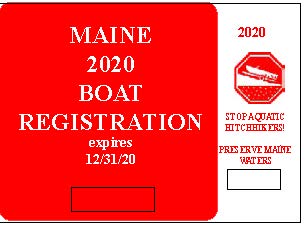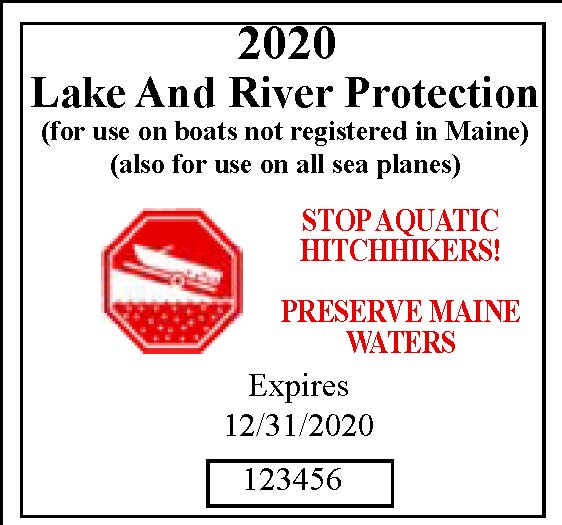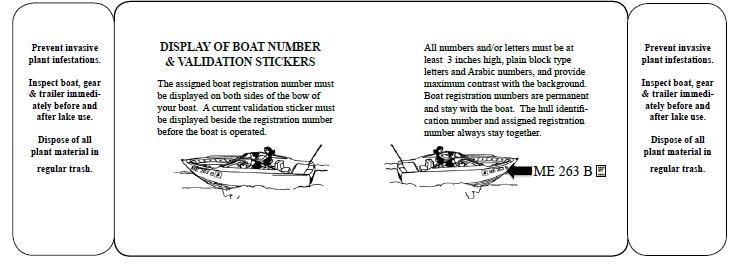Home → Water Quality → Monitoring → Invasives → Stickers
Lake and River Protection (Preserve Maine Waters) Stickers


Sticker requirement
Since 2002, all motorized watercraft operating on Maine’s inland waters are required to display a Lake and River Protection Sticker, which reads: Stop Aquatic Hitchhikers – Preserve Maine Waters. Funds from the sticker are dedicated to helping prevent the spread of aquatic invasive species.
For watercraft registered in Maine, this sticker is automatically included with the annual registration and is affixed directly to the registration decal.
Owners of watercraft registered outside of Maine must purchase and display a separate sticker before operating on inland waters.
No sticker is required for boats used exclusively in tidal waters. For details on the boundary between tidal and inland waters on specific rivers, please contact Maine Department of Inland Fisheries and Wildlife.
Note: “Motorized watercraft” includes any boat powered by a motor—gas or electric—including canoes with electric motors and personal watercraft (e.g., jet skis).
For more information on sticker cost and where to purchase, please visit the Maine Department of Inland Fisheries and Wildlife website page.
Commonly Asked Questions
You can obtain additional information from the DEP at 1-800-452-1942 or by calling the Department of Inland Fisheries and Wildlife (DIFW) at 287-8000. Staff contacts at DEP: John McPhedran, Toni Pied, Chris Reily, and Denise Blanchette.
- What are "Invasive Species?"
- Invasive species are plants, animals and even microbes that are introduced from other regions and aggressively out-compete native species.
- How are Invasive Species spread?
- Invasive Species are usually spread as a result of peoples' activities. Examples include carp from illegal fish stocking, Eurasian milfoil from boat and gear transport, and zebra mussels from engine cooling water and live wells.
- What harm do these critters do?
- It varies with each species. For example, invasive aquatic plants can grow densely, crowd out native plants, reduce fish movement, stunt growth, shade out the bottom, reduce the number of snails and other useful animals, and change water chemistry in dense plant beds.
- What's at stake?
- Every year in the United States , government agencies and private citizens spend over $100 million to combat invasive aquatic plants. Closer to home, Vermont has spent over $6 million since 1980 to control these plants, and this year expects over $700,000 in requests from municipalities for help in dealing with the problem. In addition, invasive species cost billions of dollars in lost recreation and property values, and ruin habitat for native species.
- Does Maine have a lot of invasive species?
- Right now, Maine has at least 45 invasive species ranging from green crab in ocean waters to white carp in a number of rivers. There are literally scores of other invasive species that have spread into other New England States in the last few decades. Maine has documented 25 water bodies with invasive variable milfoil, and three lakes that each contain one of the following invasive species: Eurasian milfoil, Hydrilla and Curly-leaf Pondweed.
- Aren't all plants good for fish like bass?
- Plant life in lakes and streams is essential to good fisheries. In moderate densities, aquatic plants provide just the right blend of cover and edge for successful fish growth and places to produce forage for smaller fish. The very dense growths of plants often seen with invasive species like milfoil and water chestnut have the opposite effect.
- What is Maine doing about this problem?
- In 2000 Maine launched an effort to prevent the spread of invasive species, starting with aquatic plants, the most obvious problem. This includes educating people how to avoid spreading plants, how to watch out for them, and what to do if you find them. The effort also includes thousands of voluntary boat inspections by wardens and volunteers, information given to incoming motorists, and projects to eradicate new infestations where possible. We are also cooperating with other states in our region along with federal agencies.
- Why bother to do all this if the plants are going to get here anyway?
- We know from other states' experiences that we can slow down the spread and even prevent introductions in at least some instances. Because less than 1 percent of Maine 's 6,000 lakes and ponds have been documented to contain an invasive aquatic plant species, prevention is the most realistic and practical option available for protecting Maine inland water bodies.
